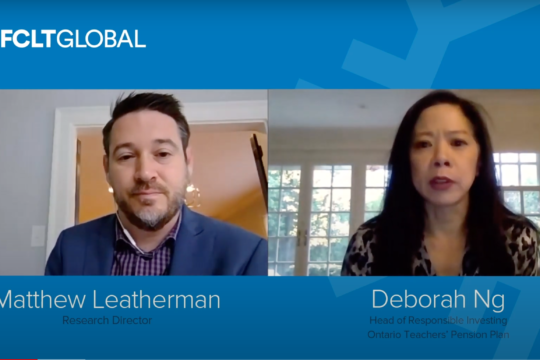
“The goal is to prove consistently that climate risk is investment risk” – Larry Fink

“The goal is to prove consistently that climate risk is investment risk” – Larry Fink
By Allen He and Devin Weiss
A growing list of public companies have made a net-zero commitment in the wake of the 2015 Paris Agreement, pledging to transition towards carbon neutrality by 2050. To that goal, hundreds of companies (including large, multinational corporations like Walmart and BP) have joined initiatives like the Carbon Disclosure Project (CDP), Task Force on Climate-Related Financial Disclosures (TCFD), and Science Based Targets Initiative (SBTi). However, many companies wonder whether their long-term climate commitments have had any material impact on their current market value. A material difference in market value following the announcement of a net-zero commitment could suggest that markets may be taking a long-term view towards valuing climate change. Conversely, if the efforts of these commitments are going unaccounted for, capital markets may instead be exhibiting short-term behavior, overly discounting the future impact of such a commitment.
Existing literature suggests that the state of public company decarbonization varies both regionally and by industry. In addition, regardless of materiality, many companies are willing to help achieve crucial Paris benchmarks, and in some cases, are rewarded in doing so. Overall, we find that:
2019 Percentage of Companies Committing to a Net-Zero Framework (by country)2
However, to our knowledge, there has been little attempt to quantify if, and by how much, net-zero commitments have impacted the market value of a company.
As part of our climate research, FCLTGlobal launched work to attempt to identify the value capital markets are currently placing on a public company’s net-zero commitment, testing to see if capital markets currently reflect the long-term nature of such commitments. Using an original dataset identifying companies’ net-zero commitment dates, we plan to test a series of often-heard hypotheses to quantify their value.
Hunting for a market signal naturally comes with some trial-and-error. We intend to evaluate the impact of a net-zero commitment announcement on P/E ratios, abnormal return or volume traded, the shape of the issuer’s yield curve, the cost of capital, impact on the “E” component of an issuer’s ESG rating, among others. It is worth noting that while not every hypothesis may lead to a quantifiable market value impact, even non-significant results can help debunk commonly held beliefs on whether a net-zero commitment results in a material difference in value for a particular market segment. Ultimately, our goal is to put concrete numbers behind the market value (or lack thereof) of a public company’s net-zero commitment and identify which aspects of climate risk can and cannot already be classified as investment risk.
We hope to gather further insights from members and other subject matter experts on whether they know of any existing resources on the topic, and which other hypothesis they may have in quantitatively assessing the impact of a net-zero commitment. If you have insights relevant to quantifying the market value of a net-zero commitment, or any questions about our work, please contact [email protected].
1. See figure 20.
2. FCLTGlobal analysis from FactSet using 2019 MSCI ACWI constituent companies and Science Based Targets Initiative (SBTi).

Policy and Geopolitics | Article
9 December 2020 - A sound, future-oriented policy from the White House would enable the US to lead on reshaping capital markets to focus capital on the long term.

Risk and Resilience, Climate | Video
11 November 2020 - Climate change is the largest systemic risk in the view of many long-term investors, and investors are pioneering ways to address this risk, including work to apply existing risk statistics specifically to climate projection and to pioneer new estimates. Projections like these about the impact of climate change on investment performance would represent enormous progress because they would advance beyond general uncertainty and instead make climate change a specific component of risk management.

Stakeholder Capitalism, Metrics, Climate | Article
28 January 2020 - A focus on stakeholders takes top billing, with a shift toward real action on climate and metrics